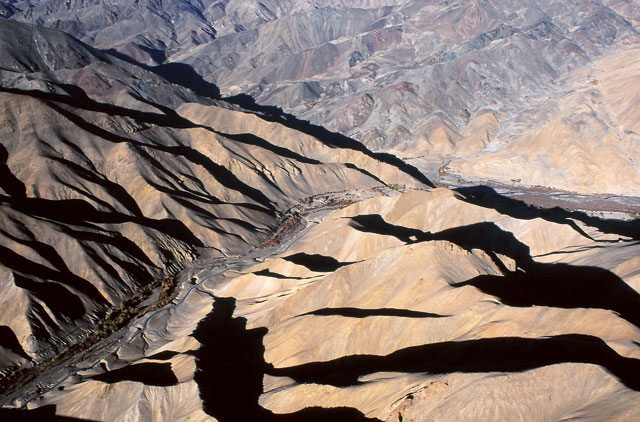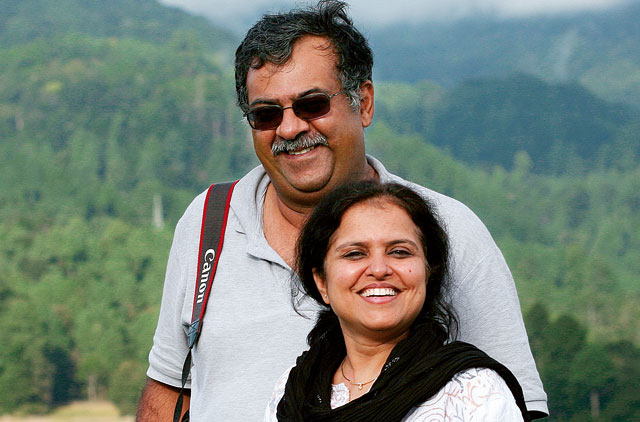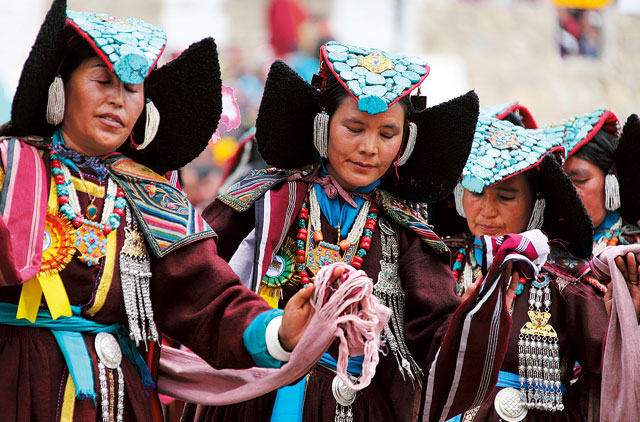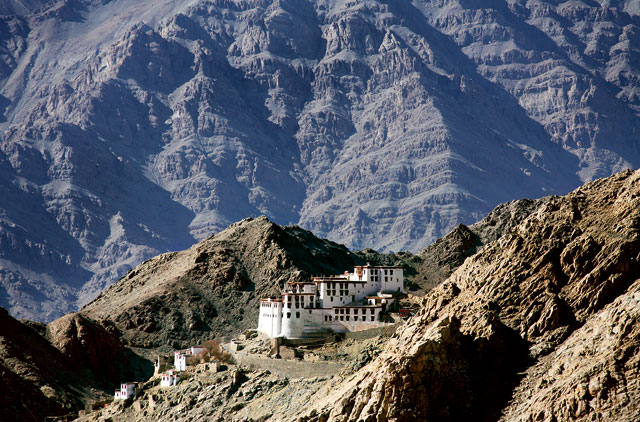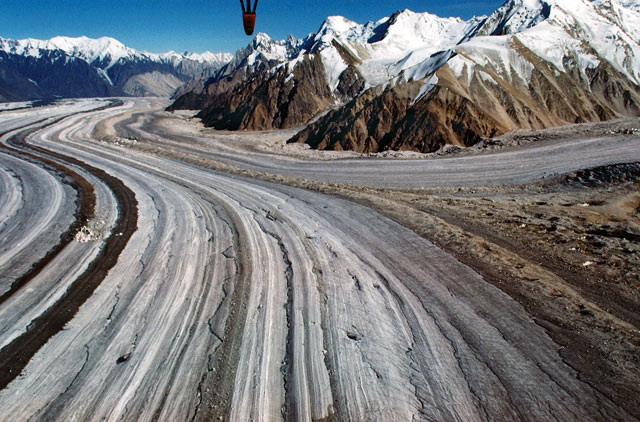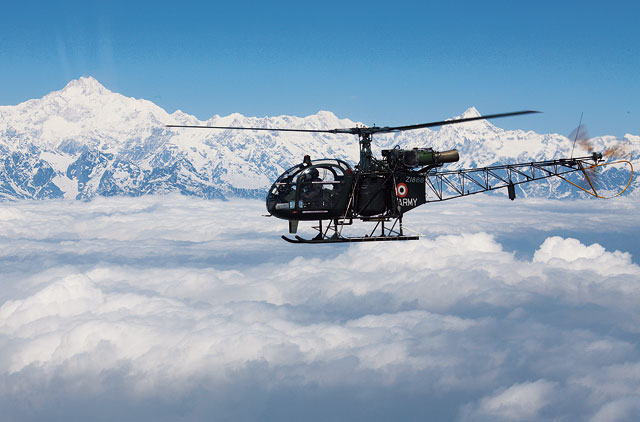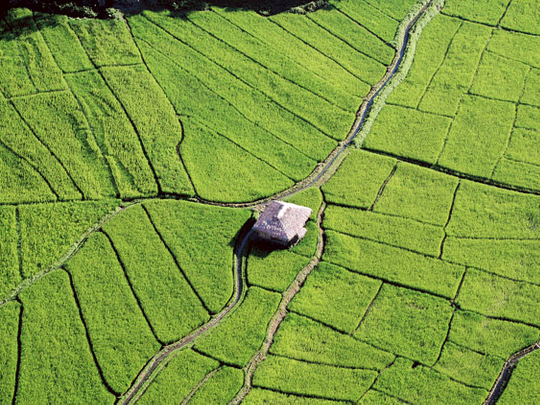
Kunal Verma still shudders when he recalls the heart-stopping moment when he thought he was going to die. He was in a Kiran Mark II -a twin-seater trainer aircraft used by the Indian Air Force and Navy - and was flying over the Arabian Sea filming the western coast of India with another similar aircraft in tow. A highly acclaimed aerial photographer, filmmaker and author, his brief included taking an aerial photograph of a Kiran in flight which was why the second aircraft was also in the air and close to Kunal's plane.
"Everything seemed to be going great and I was capturing some lovely images,'' he recalls. "We were flying at airspeeds in the region of180 knots when suddenly the pilots realised that they'd got into a horrible mess and were headed for imminent collision.''
Instantly he knew it was a mistake. In the early Nineties, Kunal had shot an acclaimed film called Salt of the Earth about the Indian Air Force. "The mantra one followed when shooting in fighter aircraft was to be absolutely meticulous and plan all the shots on the ground, especially if additional aircraft were involved. In this case, we obviously hadn't done our homework well enough for we suddenly found ourselves on a collision course with the other Kiran,'' he says. "The pilots could see the aircraft were on the same flight path.''
The white-knuckle moment lasted barely a few moments. "Luckily, at the very last instant, my pilot and the one coming our way banked hard, fortunately in opposite directions. And we survived.
"But those few micro-seconds when it looked like it was all over are still etched in my mind,'' says the 51-year-old photography veteran.
"The pilots and I were still trembling hours after we had landed.''
That was in 1996 and luckily it didn't stop Kunal's stratospheric career. No stranger to danger and adventure, Kunal along with his wife Dipti Bhalla, who has co-authored books with him, has flown in fighter jets, fixed-wing aircraft and helicopters over some of the most treacherous terrain in India, capturing scenes and images many photographers can only dream of. Apart from specialising in aerial photography, he is also a highly respected wildlife filmmaker, having made a series of films on conservation for the Project Tiger series which was telecast on Doordarshan - India's national TV channel - in 1987.
Two of his films - The Standard Bearers about the Indian National Defence Academy and one on the IAF called Aakash Yodha - were part of a dozen films selected by the Discovery Channel from approximately 2,500 entries for the prestigious Discover India segment in 2004. "I was delighted when both the films made the grade,'' says Kunal, who has been shooting for close to three decades.
He is currently working on a major project - a pictorial coffee-table book on the Indian Himalayas, Knocking on Heaven's Door. "It will document the entire sweep of the world's largest mountain range within India, from the Karakoram and Siachen in the west to the extreme corners of Arunachal Pradesh in the east,'' he says.
He has also written Ocean to Sky: India from the Air (Roli Books), The Long Road to Siachen: The Question Why (Rupa & Co) and with Dipti co-authored the recently published and highly acclaimed Northeast Trilogy (KaleidoIndia) documenting the tribes and the people of the Northeastern part of India. "I've been extremely fortunate in that I've shot in virtually every corner of India,'' says Kunal. "I particularly enjoyed filming the islands in the Nicobar and Little Andaman region from the open-back hatch of an AN 32, a twin-engined turboprop military transport aircraft.
"Dipti and I also shot a film in the waters off Lakshadweep. I bought an underwater housing for the movie camera in Dubai in 1993 and had a whale of time shooting underwater. Scuba diving and extreme flying conditions are actually quite similar.''
Kunal, a commerce graduate, says he always had a passion for travel and wildlife. So it came as no surprise to his father - Ashok Kalyan Verma, a retired Major General from the Indian Army who has written a few books on military history - and his mother, Usha, a teacher, when he decided to take up a job with a British adventure travel company immediately after graduation.
"My task as a trek manager was to follow the traditional routes that existed between the Kashmir Valley and the trans-Himalayan region of Zanskar and Ladakh, the northernmost part of India, and see if it was feasible for small groups to go on trips along these trails,'' he says. "Most of this was high-altitude work - ranging between 3,000m and 5,700m - and it was through mostly unexplored country. People in some of the remote villages had never seen anybody from the outside world.''
One frame at a time
Armed with a Pentax camera Kunal began to photograph the picturesque locales he was visiting and soon found that he had "some incredible shots which had more to do with the awesome terrain and the opportunity, rather than any skill on my part''.
Kunal credits his love for the outdoors to his father who coincidentally was commanding a brigade in Ladakh at the time his son was exploring the region.
"My dad's enthusiasm for the outdoors was infectious and I followed him into the world of wildlife - especially birds and plants. Also, both my parents were pretty good artists. You start looking at life a bit differently when you are brought up in that environment,'' Kunal says.
The few years he spent with the travel company helped hone his skills as photographer and also served to heighten his awareness of and love of the outdoors.
During the freezing winter months when Ladakh virtually shut down to the rest of the world, the Indian operations were put on hold. "We moved to the Royal Chitwan Reserve in Nepal where Tiger Tops Jungle Lodge, the pioneer of luxury tourism in Asia, had its main resort. It was here that I honed my skills as a naturalist and in white water rafting."
The field experience at Tiger Tops made it clear to Kunal just how easily people could harm the environment.
He felt the only way to protect the fragile ecology was to educate people on the importance of protecting their surroundings. So in 1993 he quit his job and moved into journalism where he began to specialise in eco-related articles for India Today before moving to Associated Press where he contributed major wildlife stories including one on man-eating tigers in the Sunderbans and also on the outbreak of child-snatching wolves in Hazaribagh, Bihar.
"The next obvious step was wildlife films,'' says Kunal. "In 1986-87, I shot the bulk of the Project Tiger series for television, once again learning on the job rather than in any classroom. It wasn't that easy, but I had people who were willing to back me and that made a big difference." At that time the woman he was later to marry, Dipti Bhalla, was the director of the Project Tiger series and after the project the pair set up their own company, KaleidoIndia.
"Under this banner we made a few more wildlife films, notably the Call of the Wild series for the Department of Tourism.''
The Project Tiger days remain special to him. "Right from the beginning I had a very good working relationship with Dipti,'' says Kunal. The relationship, of course, flourished and the couple now have two daughters Vallika, 17, and Veeha, 14. Kunal also has a pet - a three year old Labrador retriever, Admiral Blaise.
A career takes off
It was in 1992, when the Indian Air Force wanted a film made on their history and turned to KaleidoIndia, that Kunal got the country to sit up and take notice of his work. "The doyen of Indian business and aviation, JRD Tata, offered to fund the film,'' he recalls. "We looked around for aerial cameramen, but then I realised I probably had as good a chance in doing the job as anyone else.''
Of course, the project wasn't easy. "The biggest problem we faced was that there was no one to really advise you - shooting from fighter aircraft was quite difficult as you are moving at a terrific speed and you have to get the angles and frames right pretty much the first time.
"To make matters worse, we were on the 16-millimetre format at that time and the cameras were bulky. Batteries came in large heavy packs while film had to be fitted on top in magazines that were then clamped on top of the main body of the camera. In a fighter cockpit, shooting with all this equipment was impossible so we had to shoot with smaller internal spools of film, which at best would give two to three minutes of running footage.''
They had to make several sorties as it took Kunal time to replace the film in the cameras. Dipti, also an accomplished photographer, became the first woman at the time to fly in supersonic fighters like the Mirage 2000 and the Jaguar for the shoot.
But the hard work that went into that first aerial film - Salt of the Earth - took the aerial-photography world by storm and propelled the Vermas into the national spotlight.
The film also became a benchmark of sorts in defence documentaries. The fast-paced movie was shown at venues across the country and thrust viewers into a hitherto unfamiliar world.
A feel-good film
Tata, in his brief to the film-makers, had said, "Make a film which makes this country feel good." After the film was shown, all fighter, transport and helicopter pilots were said to be walking on air, and an entire generation wanted to step into the shoes of the pilots and fly the latest aircraft such as Tiger Moths, Tempests, Gnats, Hunters and MiGs - each a legend in its generation of aircraft types.
"That particular film was a truly amazing one because we put a lot of hard work and effort into it,'' says Kunal. "But then, every sortie one flies is a dream by itself and extremely fulfilling.''
Another project that he holds close to his heart is the one he did last May.
"I'd been trying for years to get some really good shots of the 8,586m Kanchenjunga, the tallest peak in India and the third highest mountain in the world. I twice even flew over it in a MiG 21,'' says Kunal. "But somehow the peak always had lots of cloud cover around it and I could never get a clear shot.''
Then one day, the imposing mountain situated on the border between Sikkim in northeastern India and Nepal, and which is part of the great Himalayan range, offered Kunal another chance.
"The weather was good, the cloud cover was pretty thin ... conditions just ideal to shoot the mountain. We took off from Sevoke Road near Siliguri, flying across Sikkim in a pair of helicopters. We then approached the massif from the northern side and crested the flying ceiling of the Cheetah - the highest altitude it can fly - at around 7,620 metres above sea level.
"It was incredible. We were in a glass bubble with blue skies all around. I could look down on several mountains on the Chinese side and look up at the Kanchenjunga piercing the sky to my right. It was extremely difficult flying but the pictures I got that day were easily among the best I've ever seen of the mountain,'' says Kunal. His one regret though is that "I can't fly (officially)! I've handled fighters in the air but its always under supervision in a trainer."
Dying a thousand deaths
Ask him if there is an incident that still remains in his mind and he will relate one which occurred in 2001 while shooting a second film for the Indian Air Force.
"We were part of a three-aircraft formation of MiG 29 aircraft flying over Zanskar, in Kashmir, India. We had the Great Himalayan Range to our left and I was looking for a head-on shot of a MiG with this spectacular mountainous backdrop," he says. "Once we were in position over the designated area, we had to do a few manoeuvres including banking sharply to the left and right, sometimes flying upside down to get the right kind of shot. I must say I died a thousand deaths on that particular sortie - but I managed to keep the cameras rolling despite experiencing some extreme Gs.'' He is talking about G forces - the pressure exerted on the human body by acceleration - which can cause the blood to drain from your head leaving you momentarily unconscious.
From shooting fighter aircraft thousands of metres above the earth to coming down on terra firma to capture living creatures, Kunal enjoys doing all kinds of projects, particularly those that involve photographing tigers.
"I saw my first tiger when I was four years old,'' he says. "We were driving into Kanha National Park in Madhya Pradesh in the family car and there was this majestic guy sleeping stretched across the road. I can't say that I decided then and there to shoot wildlife films but that one image of the tiger, his yellow eyes and every rippling sinew of his body, got permanently imprinted on my mind.''
Kunal is keen to pass information on to budding photographers, saying, "One lesson I learnt in aerial photography is that while in the mountains, you have to take things as they come. You cannot compete with nature, for the moment you think you've got things covered, there is a rude shock awaiting you just around the corner. For instance, you could set of on a fine day to shoot a mountain but in a jiffy, the weather could change and rain, snow or winds could ruin your shoot day.
"Also, one cannot take things at face value or ignore conventional wisdom. This is especially true when it comes to the weather. It's also very important to set yourself moderate goals - problems start when we try to overreach.''
Kunal is excited about his latest book. "While shooting for the Northeast Trilogy, last year we flew close to 400 hours, which allowed me to access the remotest corners of Sikkim and Arunachal. By combining various forms of photography - aerial, people, wildlife, flowers and birds - we are able to present quite an unprecedented and spectacular canvas in Knocking on Heaven's Door,'' he says .
"The most rewarding moments? The fact that I've been able to capture some stunning locales in the most challenging situations and can offer it to people in the comfort of their homes."



